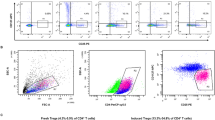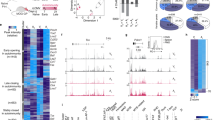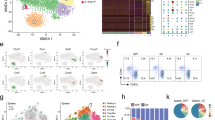Abstract
We have recently shown that targeted expression of myelin oligodendrocyte glycoprotein (MOG) to dendritic cells with self-inactivating-lentivirus vectors induces antigen-specific tolerance in naive antigen-specific CD4+ T cells and protects mice from experimental autoimmune encephalomyelitis (EAE). In the present study, we demonstrate that this approach also induces tolerance of activated antigen-specific CD4+ T cells and completely protects mice from passive EAE induction. Tolerance induction did not correlate with the depletion of the preactivated antigen-specific CD4+ T cells. However, upon isolation and in vitro re-stimulation at day 6 after adoptive transfer the MOG-specific CD4+ T cells from the non-tolerized mice produced large amounts of inflammatory cytokines, whereas those from tolerized mice did not. This unresponsiveness correlated with the upregulation of regulatory molecules associated with anergy and regulatory T cells (Tregs). The in vivo depletion of Tregs resulted in EAE susceptibility of the tolerized animals, suggesting that these cells have indeed a role in tolerance induction/maintenace.
This is a preview of subscription content, access via your institution
Access options
Subscribe to this journal
Receive 12 print issues and online access
$259.00 per year
only $21.58 per issue
Buy this article
- Purchase on Springer Link
- Instant access to full article PDF
Prices may be subject to local taxes which are calculated during checkout





Similar content being viewed by others
References
Briggs FBS, Goldstein BA, McCauley JL, Zuvich RL, De Jager PL, Rioux JD et al. Variation within DNA repair pathway genes and risk of multiple sclerosis. Am J Epidemiol 2010; 172: 217–224.
Lin X, Deng F, Mo X, Wu L, Lei S . Functional relevance for multiple sclerosis-associated genetic variants. Immunogenetics 2014; 67: 7–14.
Comabella M, Craig DW, Camiña-Tato M, Morcillo C, Lopez C, Navarro A et al. Identification of a novel risk locus for multiple sclerosis at 13q31.3 by a pooled genome-wide scan of 500 000 single nucleotide polymorphisms. PLoS One 2008; 3: e3490.
Patsopoulos NA, de Bakker PIW . Genome-wide meta-analysis identifies novel multiple sclerosis susceptibility loci. Ann Neurol 2011; 70: 897–912.
Haas J, Korporal M, Schwarz A, Balint B, Wildemann B . The interleukin-7 receptor α chain contributes to altered homeostasis of regulatory T cells in multiple sclerosis. Eur J Immunol 2011; 41: 845–853.
Alcina A, Fedetz M, Ndagire D, Fernández O, Leyva L, Guerrero M et al. IL2RA/CD25 gene polymorphisms: uneven association with multiple sclerosis (MS) and type 1 diabetes (T1D). PLoS One 2009; 4: e4137.
Zuvich RL, McCauley JL, Oksenberg JR, Sawcer SJ, de Jager PL, Aubin C et al. Genetic variation in the IL7RA/IL7 pathway increases multiple sclerosis susceptibility. Hum Genet 2010; 127: 525–535.
Lunemann JD, Jelcic I, Roberts S, Lutterotti A, Tackenberg B, Martin R et al. EBNA1-specific T cells from patients with multiple sclerosis cross react with myelin antigens and co-produce IFN- and IL-2. J Exp Med 2008; 205: 1763–1773.
Serafini B, Rosicarelli B, Franciotta D, Magliozzi R, Reynolds R, Cinque P et al. Dysregulated Epstein-Barr virus infection in the multiple sclerosis brain. J Exp Med 2007; 204: 2899–2912.
Pender MP, Csurhes PA, Smith C, Beagley L, Hooper KD, Raj M et al. Epstein-Barr virus-specific adoptive immunotherapy for progressive multiple sclerosis. Mult Scler 2014; 20: 1541–1544.
Hansdottir S, Monick MM, Hinde SL, Lovan N, Look DC, Hunninghake GW . Respiratory epithelial cells convert inactive vitamin D to its active form: potential effects on host defense. J Immunol 2008; 181: 7090–7099.
Ramagopalan SV, Lee JD, Yee IM, Guimond C, Traboulsee AL, Ebers GC et al. Association of smoking with risk of multiple sclerosis: a population-based study. J Neurol 2013; 260: 1778–1781.
Lehmann-Horn K, Kronsbein HC, Weber MS . Targeting B cells in the treatment of multiple sclerosis: recent advances and remaining challenges. Ther Adv Neurol Disord 2013; 6: 161–173.
Amedei A, Prisco D, D’Elios M . Multiple sclerosis: the role of cytokines in pathogenesis and in therapies. IJMS 2012; 13: 13438–13460.
Goverman JM . Immune tolerance in multiple sclerosis. Immunol Rev 2011; 241: 228–240.
Hemmer B, Nessler S, Zhou D, Kieseier B, Hartung H . Immunopathogenesis and immunotherapy of multiple sclerosis. Nat Clin Pract Neurol 2006; 2: 201–211.
Greter M, Heppner FL, Lemos MP, Odermatt BM, Goebels N, Laufer T et al. Dendritic cells permit immune invasion of the CNS in an animal model of multiple sclerosis. Nat Med 2005; 11: 328–334.
Codarri L, Gyülvészi G, Tosevski V, Hesske L, Fontana A, Magnenat L et al. RORγt drives production of the cytokine GM-CSF in helper T cells, which is essential for the effector phase of autoimmune neuroinflammation. Nat Immunol 2011; 12: 560–567.
Bouneaud C, Kourilsky P, Bousso P . Impact of negative selection on the T cell repertoire reactive to a self-peptide: a large fraction of T cell clones escapes clonal deletion. Immunity 2000; 13: 829–840.
Bielekova B, Sung M, Kadom N, Simon R, McFarland H, Martin R . Expansion and functional relevance of high-avidity myelin-specific CD4+ T cells in multiple sclerosis. J Immunol 2004; 172: 3893–3904.
Walker LS, Abbas AK . The enemy within: keeping self-reactive T cells at bay in the periphery. Nat Rev Immunol 2002; 2: 11–19.
Lutz MB, Kukutsch NA, Menges M, Rössner S, Schuler G . Culture of bone marrow cells in GM-CSF plus high doses of lipopolysaccharide generates exclusively immature dendritic cells which induce alloantigen-specific CD4 T cell anergy in vitro. Eur J Immunol 2000; 30: 1048–1052.
Macián F, Im S, García-Cózar FJ, Rao A . T-cell anergy. Curr Opin Immunol 2004; 16: 209–216.
Yang J, Xu L, Huang Y, van der Meide PH, Link H, Xiao B . Adherent dendritic cells expressing high levels of interleukin-10 and low levels of interleukin-12 induce antigen-specific tolerance to experimental autoimmune encephalomyelitis. Immunology 2000; 101: 397–403.
Latchman YE, Liang SC, Wu Y, Chernova T, Sobel RA, Klemm M et al. PD-L1-deficient mice show that PD-L1 on T cells, antigen-presenting cells, and host tissues negatively regulates T cells. Proc Natl Acad Sci USA 2004; 101: 10691–10696.
Salama AD, Chitnis T, Imitola J, Ansari MJI, Akiba H, Tushima F et al. Critical role of the programmed death-1 (PD-1) pathway in regulation of experimental autoimmune encephalomyelitis. J Exp Med 2003; 198: 71–78.
Zhou X, Kong N, Zou H, Brand D, Li X, Liu Z et al. Therapeutic potential of TGF-β-induced CD4+Foxp3+regulatory T cells in autoimmune diseases. Autoimmunity 2011; 44: 43–50.
Zhang X, Koldzic DN, Izikson L., Reddy J., Nazareno RF, Sakaguchi S et al. IL-10 is involved in the suppression of experimental autoimmune encephalomyelitis by CD25+CD4+ regulatory T cells. Int Immunol 2004; 16: 249–256.
Walker LSK, Sansom DM . The emerging role of CTLA4 as a cell-extrinsic regulator of T cell responses. Nat Rev Immunol 2011; 11: 852–863.
de Andrade Pereira B, Fraefel C, Hilbe M, Ackermann M, Dresch C . Transcriptional targeting of DCs with lentiviral vectors induces antigen-specific tolerance in a mouse model of multiple sclerosis. Gene Therapy 2012; 20: 556–566.
Dresch C, Ackermann M, Vogt B, de Andrade Pereira B, Shortman K, Fraefel C . Thymic but not splenic CD8+ DCs can efficiently cross-prime T cells in the absence of licensing factors. Eur J Immunol 2011; 41: 2544–2555.
Dresch C, Edelmann SL, Marconi P, Brocker T . Lentiviral-mediated transcriptional targeting of dendritic cells for induction of T cell tolerance in vivo. J Immunol 2008; 181: 4495–4506.
Takahashi T, Kuniyasu Y, Toda M, Sakaguchi N, Itoh M, Iwata M et al. Immunologic self-tolerance maintained by CD25+CD4+ naturally anergic and suppressive T cells: induction of autoimmune disease by breaking their anergic/suppressive state. Int Immunol 1998; 10: 1969–1980.
Carrithers MD . Update on disease-modifying treatments for multiple sclerosis. Clin Ther 2014; 36: 1938–1945.
Castro-Borrero W, Graves D, Frohman TC, Flores AB, Hardeman P, Logan D et al. Current and emerging therapies in multiple sclerosis: a systematic review. Ther Adv Neurol Disord 2012; 5: 205–220.
Turley DM, Miller SD . Peripheral tolerance induction using ethylenecarbodiimide-fixed APCs uses both direct and indirect mechanisms of antigen presentation for prevention of experimental autoimmune encephalomyelitis. J Immunol 2007; 178: 2212–2220.
Lutterotti A, Yousef S, Sputtek A, Sturner KH, Stellmann J, Breiden P et al. Antigen-specific tolerance by autologous myelin peptide-coupled cells: a phase 1 trial in multiple sclerosis. Sci Transl Med 2013; 5: 188ra75.
Zhou F, Lauretti E, Di Meco A, Ciric B, Gonnella P, Zhang G et al. Intravenous transfer of apoptotic cell-treated dendritic cells leads to immune tolerance by blocking Th17 cell activity. Immunobiology 2013; 218: 1069–1076.
Zhou F, Ciric B, Zhang G, Rostami A . Immune tolerance induced by intravenous transfer of immature dendritic cells via up-regulating numbers of suppressive IL-10+ IFN-γ+-producing CD4+ T cells. Immunol Res 2013; 56: 1–8.
Getts DR, Martin AJ, McCarthy DP, Terry RL, Hunter ZN, Yap WT et al. Microparticles bearing encephalitogenic peptides induce T-cell tolerance and ameliorate experimental autoimmune encephalomyelitis. Nat Biotechnol 2012; 30: 1217–1224.
Ko H, Chung J, Nasa Z, Chan J, Siatskas C, Toh B et al. Targeting MOG expression to dendritic cells delays onset of experimental autoimmune disease. Autoimmunity 2011; 44: 177–187.
Chan J, Ban EJ, Chun KH, Wang S, Backstrom BT, Bernard CCA et al. Transplantation of bone marrow transduced to express self-antigen establishes deletional tolerance and permanently remits autoimmune disease. J Immunol 2008; 181: 7571–7580.
Nasreen M, Waldie TM, Dixon CM, Steptoe RJ . Steady-state antigen-expressing dendritic cells terminate CD4+ memory T-cell responses. Eur J Immunol 2010; 40: 2016–2025.
Kenna TJ, Waldie T, McNally A, Thomson M, Yagita H, Thomas R et al. Targeting antigen to diverse APCs inactivates memory CD8+ T cells without eliciting tissue-destructive effector function. J Immunol 2010; 184: 598–606.
McNeill A, Spittle E, Bäckström BT . Partial depletion of CD69 low -expressing natural regulatory T Cells with the anti-CD25 monoclonal antibody PC61. Scand J Immunol 2007; 65: 63–69.
Betts RJ, Ho AWS, Kemeny DM, Unutmaz D . Partial depletion of natural CD4+CD25+ regulatory T cells with anti-CD25 antibody does not alter the course of acute influenza A virus infection. PLoS One 2011; 6: e27849.
Martinez NE, Karlsson F, Sato F, Kawai E, Omura S, Minagar A et al. Protective and detrimental roles for regulatory T cells in a viral model for multiple sclerosis. Brain Pathol 2014; 24: 436–451.
Fransson M, Piras E, Burman J, Nilsson B, Essand M, Lu B et al. CAR/FoxP3-engineered T regulatory cells target the CNS and suppress EAE upon intranasal delivery. J Neuroinflammation 2012; 9: 112.
Kohm AP, Carpentier PA, Anger HA, Miller SD . Cutting edge: CD4+CD25+ regulatory T cells suppress antigen-specific autoreactive immune responses and central nervous system inflammation during active experimental autoimmune encephalomyelitis. J Immunol 2002; 169: 4712–4716.
Tonkin DR, He J, Barbour G, Haskins K . Regulatory T cells prevent transfer of type 1 diabetes in NOD mice only when their antigen is present in vivo. J Immunol 2008; 181: 4516–4522.
Gol-Ara M, Jadidi-Niaragh F, Sadria R, Azizi G, Mirshafiey A . The role of different subsets of regulatory T cells in immunopathogenesis of rheumatoid arthritis. Arthritis 2012; 2012: 805–875.
Hagymasi AT, Slaiby AM, Mihalyo MA, Qui HZ, Zammit DJ, Lefrancois L et al. Steady state dendritic cells present parenchymal self-antigen and contribute to, but are not essential for, tolerization of naive and Th1 effector CD4 cells. J Immunol 2007; 179: 1524–1531.
Tyler KL . Human herpesvirus 6 and multiple sclerosis: the continuing conundrum. J Infect Dis 2003; 187: 1360–1364.
Acknowledgements
We thank Judith Robotka and Carla Rohrer-Bley for technical support and Dana Salathe for assistance with mice. This work was supported by funds from the Swiss Multiple Sclerosis Society and the University of Zurich.
Author information
Authors and Affiliations
Corresponding author
Ethics declarations
Competing interests
The authors declare no conflict of interest.
Rights and permissions
About this article
Cite this article
de Andrade Pereira, B., Ackermann, M., Chaudhary, S. et al. Tolerance of activated pathogenic CD4+ T cells by transcriptional targeting of dendritic cells. Gene Ther 22, 382–390 (2015). https://doi.org/10.1038/gt.2015.6
Received:
Revised:
Accepted:
Published:
Issue Date:
DOI: https://doi.org/10.1038/gt.2015.6
This article is cited by
-
An engineered Fc fusion protein that targets antigen-specific T cells and autoantibodies mitigates autoimmune disease
Journal of Neuroinflammation (2023)
-
Immune reconstitution therapies: concepts for durable remission in multiple sclerosis
Nature Reviews Neurology (2020)
-
Short-course rapamycin treatment enables engraftment of immunogenic gene-engineered bone marrow under low-dose irradiation to permit long-term immunological tolerance
Stem Cell Research & Therapy (2017)



